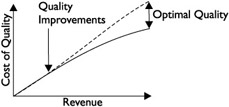The Big Quality Picture
|
| < Day Day Up > |
|
Before we hop into the three different facets of project quality management, let’s establish a few “PMI-isms” on quality. Because quality means so many different things to so many different people, it’s important to confirm we’re working with a common understanding of what quality is and what quality management hopes to accomplish—from PMI’s point of view.
Accepting the Quality Management Approach
The details and specifications set out by the customer determine what the expected level of quality is. Project quality management, as far as your exam goes, is compatible with ISO 9000 and ISO 10000 quality standards and guidelines.
Project quality management also is concerned with the management of the project and the product of the project. It’s easy to focus on the product (the thing or service the project creates), but project managers must also provide quality for the project management activities. Aspects of the downside of focusing too much on the product include:
-
Overworking the project team in order to complete the project. This may result in unacceptable work, decline in team morale, and the slow, steady destruction of the project team’s willingness to work.
-
A hurry to complete the project work by speeding through quality inspections. This can result in unacceptable deliverables
Quality vs. Grade
Quality and grade are not the same.
Quality is the sum of the characteristics of a product that allow it to meet the demands or expectations of the project. Grade, according to the PMBOK, “is a category or rank given to entities having the same functional use but different technical characteristics.” For example, there are different grades of paint, different grades of metal, and even different grades of travel.
Exam Watch
Know that low quality is always a problem, but low grade may not be. Depending on the requirements of the customer, low grade may be completely acceptable, but low quality never is.
Implementing Quality Project Management
Quality management and project management have similar characteristics:
-
Customer satisfaction The project must satisfy the customer requirements by delivering what it promised in order to satisfy the needs of the customer. The PMBOK puts it as “conformance to requirements” and “fitness for use.”
-
Prevention Quality is planned into a project, not inspected in. It is always more cost-effective to prevent mistakes than to correct them.
-
Management responsibility The project team must work towards the quality goal, but management must provide the needed resources to deliver on the quality promises.
-
Plan-do-check-act Deming, arguably the world’s leader in quality management theory thanks to his management methods implemented in Japan after World War II, set the bar with his “plan-do-check-act” approach to quality management. This approach is similar to the project management processes every project passes through.
-
Kaizen technology Kaizen is a quality management philosophy of applying continuous small improvements to reduce costs and ensure consistency or project performance.
-
Marginal analysis Marginal analysis studies the cost of the incremental improvements to a process or product and compares it against the increase in revenue made from the improvements. For example, the price of the added feature may cost the company $7.50 per unit, but the amount of gained sales per year because of the improvement will meet or exceed the cost of the improvement.

|
| < Day Day Up > |
|
EAN: 2147483647
Pages: 209